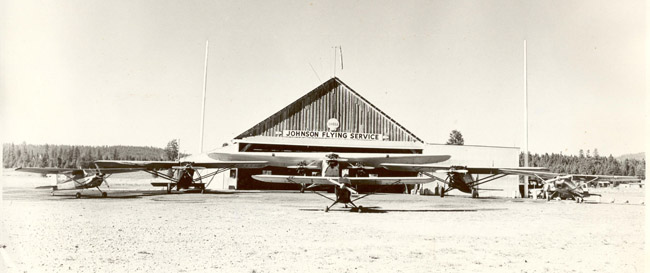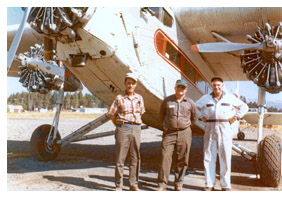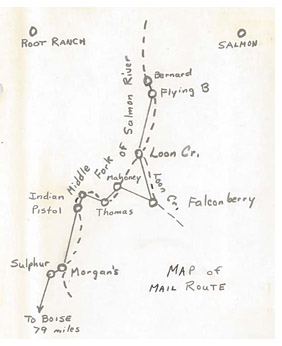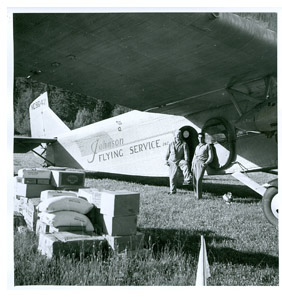

Pioneers of Idaho’s Aerial Mail Routes
Reprinted with permission from Winter 2014 iaaue of Rudder Flutter
Story by Laura Adams
Photos courtesy Bill Fogg
In Idaho, like Alaska, backcountry aerial mail contracts replaced slower dog-sled, horse-, and foot-powered transportation in the early 1900s, based primarily on the demands of an increased population base in remote locations due to the establishment of mining towns. The first major contracted aerial mail carriers in the 1930s were Bennett Air Transport Company and Johnson Flying Service. The skill level of the backcountry pilots who pioneered these routes, and those who continue to fly them, requires extensive knowledge and experience maneuvering in high-altitude strips, tougher canyons, sinking snow, and a fair amount of cross-country traffic
In his book, “Bound for the Backcountry,” Richard Holm provides the history of the three mail routes established during the 1950s to service isolated ranches, hunting camps, and US Forest Service (USFS) stations. The bones of these original routes are still in operation today.
The first major postwar route was called the Cabin Creek Route, and it was later renamed the Salmon River Star Route (or the main Salmon). This route was managed by Johnson Flying Service, out of McCall, and included 15 private airstrips and three USFS fields. Evergreen Aviation purchased Johnson Flying Service in 1975, but they did not hold the contract for the Salmon Star Route for long. Local Cascade resident, Ray Arnold, outbid the Oregon-based company and successfully won the bid for the second Middle Fork route as well.
For the first three years, the Middle Fork of the Salmon River route was contracted to Roberts Flying Service out of Boise, and it included five private, three USFS, and two state-owned airstrips. Pilot Norman Ashe flew this route for Roberts in a Piper Tri-pacer. In 1963, Roberts sold the business to Mike Loening, a Cessna dealer. Pilot Bill Scherer flew the route every Wednesday for six years until Loening sold his business to Boise Air Service, which held the contract from 1969-1975.
The contract for the third route, from McCall to Warren, was first held by pilot Bob Fogg. The route was expanded to include the South Fork of the Salmon River. In 1974, Jim Newcomb of McCall Flying Service inherited the South Fork portion, and shortly thereafter, Fogg’s route as well. Mike Dorris of McCall acquired this contract in 1981, and he continues making aerial deliveries to Warren, as well as several South Fork airstrips. His mail contract is a highway route based from McCall, permitting him to fly into a handful of airstrips when the roads are closed.
Fogg, an Idaho native, is known as the first long-standing aerial pilot within Idaho to maintain a reliable, weekly mail delivery route. Raised by his single mother, a Cascade restaurant owner, Fogg did not believe he had the means to pursue a university education to become a doctor. Instead, he decided to pursue his second career choice — aviation.
After finishing high school, Fogg worked for a local sawmill to pay for his first flying lesson at the Cascade airport from Dick Johnson, of Johnson Flying Service. This relationship paved the way for his exciting career with a company known throughout the Northwest as one of the leading pioneers in aviation. Following his retirement in 1974, Fogg was formally interviewed by Joe Bennett and Doug Jones. He had nothing but the highest praises for company owners Dick and Bob Johnson, describing them as cutting-edge entrepreneurs who “were unique in that if they could do something with an airplane, they didn’t just pass it off.” Even more so, Fogg was especially grateful to work for bosses who sincerely valued safety over financial gain.
 In 1942, Fogg began working as a flight instructor for their Missoula (Mont.) operation and eventually helped in the development of other facets of the business, such as war-service pilot training programs, air patrol for fire scouting and firefighting, smoke jumping, aerial timber spraying, aerial agricultural spraying and mail service.
In 1942, Fogg began working as a flight instructor for their Missoula (Mont.) operation and eventually helped in the development of other facets of the business, such as war-service pilot training programs, air patrol for fire scouting and firefighting, smoke jumping, aerial timber spraying, aerial agricultural spraying and mail service.
The first mail run Bob Johnson made out of Boise was in the winter of 1928 to drop mail at the mining town of Atlanta. Wooden skis with copper nailed to the bottoms were required to land there, as well as an early morning departure to ensure that the soaked grass was frozen solid for take-off. A couple years later, the Johnson’s hired pilot Gordon Moore to fly the Idaho Highline out of Cascade, which included mining stops such as Stibnite, Yellow Pine and Big Creek.
Previously, dog teams were used for deliveries into these mining towns, but Johnson felt an airplane could easily compete with the several-day journey through the mountaineous terrain, and they developed ski flying with a Travel Air 6000 for most of this type of winter work. Fogg explained, “Even though there had been ski flying, and lots of it, done in Alaska, Johnson developed some of the principals that were used in making an airplane slide in the snow conditions specific to Idaho…. They finally wound up using a concoction of whale oil, bee’s wax, and rosin to apply to the bottom of the skis. You would heat it up, while simultaneously using a blowtorch to heat up the ski, and then paintbrush it on while it was real hot. It would last an average day of flying, six or eight landings.”
Fogg permanently relocated to McCall in 1943 as the manager of that base where he pioneered the regular mail service route along the Salmon River. Flying more than three million miles and 22,000 hours in the backcountry over 36 years lends itself to a few close calls, and Fogg was not bashful about sharing his harrowing stories. One of his favorites is a tale about taking six hours to fly out of a snow pile in Big Creek after making a January hay delivery. His closest, deadliest experience happened while working on a fire right at the mouth of the Middle Fork of the Salmon River, dropping cargo with a Travel Air.
Reminiscing he admitted, “I had perhaps become a little negligent, in thinking back…. That is what has killed a couple of other pilots as well, a downwind turn. It’s a no-no. I always watched it after that.”
During the height of Fogg’s career in the early 1960s, Bill Scherer began flying a regular Wednesday U.S. Postal Service contract to 10 isolated stations along the Middle Fork of the Salmon River. The list included Sulphur Creek, Morgan Ranch, Pistol Creek, Indian Creek, Thomas Creek, Mahoney, Falconberry Ranch, Lower Loon Creek, Bernard, and Flying B Ranch. A 1964 issue of The Cessna Pennant documented a story about Scherer entitled “Post Office with Wings” highlighting the details of his unique job description. Scherer got to fly an array of aircraft because Loening was a Cessna dealer, but he was most often seen in the Cessna twin-engine Skymaster featured in this article. Flying out of Boise Municipal Airport, Scherer flew plenty of passengers along with bagged deer and elk from hunting expeditions. 
Each of his mail runs included 330 miles and about two hours of flying time to transport fuel, grocery orders, tractor tires, and other necessities, in addition to the standard mail parcels. No day in this business is the same, and no one knows this better than the legendary Ray Arnold, who now holds the last official aerial mail route contract in the continental United States. Over the last 40 years, Ray and his staff at Arnold Aviation have taken customer service in Idaho’s backcountry to a whole new level. "
In October, I had the pleasure of visiting Arnold Aviation and flying alongside Ray on his Wednesday route. Flying with a pilot whose plane is honestly an extension of himself, and who flies so naturally and steadily in and out of these remote airstrips, was the opportunity of a lifetime. I look forward to sharing a fascinating, in-depth and intimate account of Ray’s stories with you in the next issue.
Note: To be added to the quarterly Rudder Flutter distrivbution list, please contact Tammy Schoen at Idaho's Division of Aeronutics, at 334-8776.
Pictured top above article title is a photo of Johnson's Flying Service McCall Operations in the late '50s. Picture in top right below the article title is Bob Fogg, Bill Dorris and mechanic Wilbur Burkhart in front of Johnson's Ford 4-AT Trimotor N7861. Pictured above and to left is a map of one of the flying routes, and pictured to right is Fogg and Bob Johnson with The Ford at Red's Ranch in the Wallowa's.
Published 12-26-14